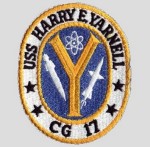USS Harry E. Yarnell (CG-17)

USS Harry E. Yarnell in 1967
|
|
| History | |
|---|---|
|
|
|
| Name: | Harry E. Yarnell |
| Namesake: | Harry E. Yarnell |
| Ordered: | 11 July 1958 |
| Builder: | Bath Iron Works, Bath, Maine |
| Laid down: | 31 May 1960 |
| Launched: | 9 December 1961 |
| Sponsored by: | Mrs. Philip Yarnell |
| Acquired: | 25 January 1963 |
| Commissioned: | 2 February 1963 |
| Decommissioned: | 20 October 1993 |
| Reclassified: | CG-17 on 30 June 1975 |
| Struck: | 29 October 1993 |
| Fate: | Sold for scrap. Scrapping completed 17 APR 2002 |
| Badge: |  |
| General characteristics | |
| Class and type: | Leahy class cruiser |
| Displacement: | 7,800 tons full load |
| Length: | 547 ft (167 m) |
| Beam: | 55 ft (17 m) |
| Draft: | 25 ft (7.6 m) |
| Propulsion: | Steam turbines, 4 1200 psi boilers, 85,000 hp, 2 shafts |
| Speed: | 30+ knots |
| Complement: | 395 |
| Armament: | |
USS Harry E. Yarnell (DLG/CG-17), a Leahy-class guided missile cruiser, was a ship of the United States Navy named in honor of Admiral Harry E. Yarnell (1875–1959). Originally called a "destroyer leader" or frigate, in 1975 she was redesignated a cruiser in the Navy's ship reclassification. She was the second of the "double-end" Leahy-class guided missile frigates to join the fleet.
Harry E. Yarnell was launched 9 December 1961 by the Bath Iron Works, Bath, Maine; sponsored by Mrs. Philip Yarnell, widow of Admiral Yarnell; and commissioned 2 February 1963 at the Boston Naval Shipyard, Captain Charles E. Nelson in command.
Harry E. Yarnell was equipped with RIM-2 Terrier surface-to-air missile launching rails both fore and aft and ASROC anti-submarine missiles, as well as more conventional torpedo tubes and guns. The new ship was fitted out at Boston and received a grim reminder that even in peacetime the sea can be a powerful enemy. While out on trials, Yarnell was diverted on 10 April 1963 to search for USS Thresher (SSN-593), the nuclear submarine later found on the bottom some 8,000 feet down. Quartering the area where the sub was last reported, the guided missile frigate found an oil slick and some debris but could not contact the lost submarine.
On her way to her new home base, Naval Station Norfolk, on 23 April, Harry E. Yarnell passed and photographed several Soviet "merchant" ships. The next few months were spent conducting training for shakedown and missile qualification. Designated to carry out standardization trials for her class as well as special acoustical tests, Yarnell spent 28 October–26 November in the Caribbean operating out of Guantanamo Bay and then returned to Norfolk.
...
Wikipedia
